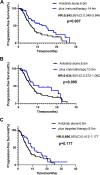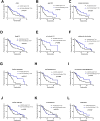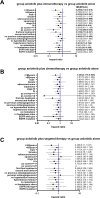Efficacy and Safety of Anlotinib-Containing Regimens in Advanced Non-Small Cell Lung Cancer: A Real-World Study
- PMID: 37720175
- PMCID: PMC10505018
- DOI: 10.2147/IJGM.S424777
Efficacy and Safety of Anlotinib-Containing Regimens in Advanced Non-Small Cell Lung Cancer: A Real-World Study
Abstract
Purpose: Anlotinib is widely used in the clinical treatment of non-small cell lung cancer (NSCLC), alone or in combination with other anticancer drugs. The aim of this study was to investigate the real-world efficacy and safety of anlotinib-containing regimens.
Patients and methods: Confirmed advanced NSCLC patients who had received anlotinib alone or in combination were enrolled. An overall analysis of the efficacy and safety of anlotinib was performed in all patients, and then subgroup analysis was used to further compare the efficacy between anlotinib monotherapy and combination therapy. The primary endpoint was progression-free survival (PFS), and the secondary endpoints were ADR, ORR, and DCR.
Results: A total of 240 patients were included. The overall median PFS was 8.5 months (95% confidence interval [CI]: 7.1-9.9 months). Anlotinib treatment regimens (monotherapy or combination therapy) and whether they received previous antiangiogenesis were associated with PFS. Anlotinib plus immunotherapy achieved longer PFS than anlotinib monotherapy (median PFS: 10.5 vs 6.5 months, p=0.007). Stratification analysis showed the PFS of anlotinib plus immunotherapy was significantly longer in male, adenocarcinoma, <=65 years old, patients stage IV, EGFR wild type, with extrathoracic metastasis, performance status scores ≥2, the first-line treatment, patients with a history of hypertension and no previous antiangiogenesis than anlotinib monotherapy. The median PFS of anlotinib plus chemotherapy, targeted therapy was slightly longer than anlotinib alone (respectively, 10.5 vs 6.5 months, p=0.095; 9.5 vs 6.5 months, p=0.177). Adverse reactions were mostly mild and acceptable, with hypertension being the most common.
Conclusion: Anlotinib is effective and tolerable in advanced NSCLC patients. Immunotherapy combination with anlotinib significantly improved PFS. The efficacy of anlotinib may be impaired by previous antiangiogenic therapy, which can be investigated in further studies.
Keywords: anlotinib; combination therapy; efficacy; immunotherapy; non-small cell lung cancer; safety.
© 2023 Sun et al.
Conflict of interest statement
The authors report no conflicts of interest in this work.
Figures





Similar articles
-
Efficacy and safety of anlotinib monotherapy or combination therapy in the treatment of patients with advanced non-small cell lung cancer: a retrospective real-world study conducted in East China.BMC Pulm Med. 2025 Apr 10;25(1):170. doi: 10.1186/s12890-025-03635-8. BMC Pulm Med. 2025. PMID: 40211232 Free PMC article.
-
Real-World Efficacy and Safety of Anlotinib With and Without Immunotherapy in Advanced Non-Small Cell Lung Cancer.Front Oncol. 2021 Jul 29;11:659380. doi: 10.3389/fonc.2021.659380. eCollection 2021. Front Oncol. 2021. PMID: 34395243 Free PMC article.
-
The Efficacy and Safety of Anlotinib in Extensive-Stage Small Cell Lung Cancer: A Multicenter Real-World Study.Cancer Manag Res. 2022 Aug 2;14:2273-2287. doi: 10.2147/CMAR.S364125. eCollection 2022. Cancer Manag Res. 2022. PMID: 35942069 Free PMC article.
-
A Meta-Analysis Assessing the Therapeutic Efficacy and Safety of Anlotinib in Combination with Chemotherapy for Small Cell Lung Cancer.Pharmacology. 2024 Dec 11:1-23. doi: 10.1159/000542769. Online ahead of print. Pharmacology. 2024. PMID: 39662070
-
Efficacy and safety of combined immunotherapy and antiangiogenesis with or without chemotherapy for advanced non-small-cell lung cancer: A systematic review and pooled analysis from 23 prospective studies.Front Pharmacol. 2022 Aug 10;13:920165. doi: 10.3389/fphar.2022.920165. eCollection 2022. Front Pharmacol. 2022. PMID: 36034821 Free PMC article.
Cited by
-
Clinical efficacy and safety of sintilimab plus oral vinorelbine as first-line treatment for newly diagnosed stage IIIB-IV nonsmall cell lung cancer patients with performance status 2 or age ≥75 years.Anticancer Drugs. 2025 Jun 1;36(5):401-407. doi: 10.1097/CAD.0000000000001699. Epub 2025 Feb 14. Anticancer Drugs. 2025. PMID: 39908219 Free PMC article.
-
Statin-Associated Liver Dysfunction and Muscle Injury: epidemiology, Mechanisms, and Management Strategies.Int J Gen Med. 2024 May 11;17:2055-2063. doi: 10.2147/IJGM.S460305. eCollection 2024. Int J Gen Med. 2024. PMID: 38751493 Free PMC article. Review.
-
Low-dose anlotinib plus immune checkpoint inhibitors offers better efficacy and safety in advanced non-small cell lung cancer treatment.Anticancer Drugs. 2025 Jun 1;36(5):408-414. doi: 10.1097/CAD.0000000000001701. Epub 2025 Feb 25. Anticancer Drugs. 2025. PMID: 39992081 Free PMC article.
-
Development and validation of a risk-prediction model for adverse drug reactions in real-world cancer patients treated with anlotinib.Ther Adv Drug Saf. 2025 Mar 22;16:20420986251328687. doi: 10.1177/20420986251328687. eCollection 2025. Ther Adv Drug Saf. 2025. PMID: 40151494 Free PMC article.
-
Research progress of anti-angiogenic therapy combined with immunotherapy and radiotherapy for the treatment of brain metastases in non-small cell lung cancer (Review).Oncol Lett. 2025 Jul 8;30(3):434. doi: 10.3892/ol.2025.15180. eCollection 2025 Sep. Oncol Lett. 2025. PMID: 40688588 Free PMC article. Review.
References
LinkOut - more resources
Full Text Sources
Research Materials
Miscellaneous

